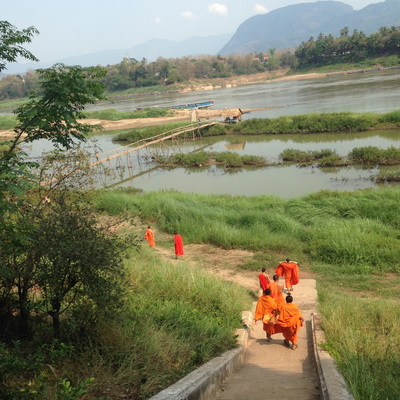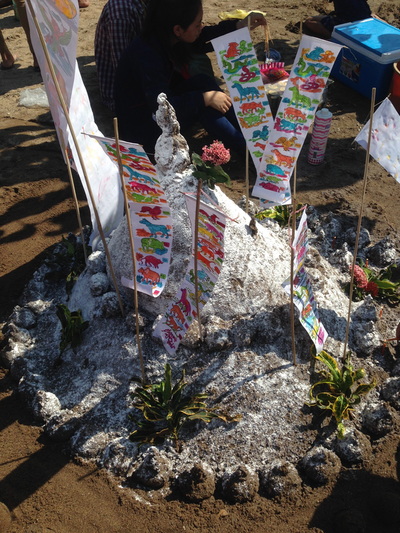|
Luang Prabang, literally meaning “Royal Buddha Image”, is the ancient capital of Laos, sitting at the confluence of the Mekong and Nam Khan rivers, surrounded by gilded temples. Luang Prabang is an outstanding example of archiectutural fusion; traditional and Lao urban structures sitting side by side buildings constructed by the European colonial authorities in the 19th and 20th centuries, Its unique, remarkably well preserved townscape illustrates a key stage in the blending of these two distinct cultural traditions. In recognition of the city’s unique cultural and historical significance, UNESCO designated Luang Prabang a world Heritage Site in 1995. What to do in Luang Prabang Discover some of the city’s finest architecture. You can wander leafy side streets where old rambling houses and villas are being renovated and people live their lives out on the streets, especially during the cool end of the day. It is a small city to get around, ride of bicycle, take a tuktuk or simply walk. 10 highlights of Luang Prabang 1. Visit Kuang Si Waterfall – or known in Lao as Tat Kuang Si, it is a three-tier waterfall about 29 kilometres (18 Mi) south of Luang Prabang. These falls are a favourite side trip for tourists in Luang Prabang. The falls begin with shallow pools which lead to the main falls and it's stunning 60 metres (200ft) cascade. The falls are accessed via trail to a left of the falls. The water collects in numerous turquoise blue pools as it flows downstream, the many cascades that result are typical of travertine waterfalls. 2. Temple tour – Luang Prabang is a city with unbelievable number of temples. All of them are absolute works of art, ornate with exclusive decoration reflecting both religious events and simple life sequences. Some of the temples date back to 16th century. Wat Xieng Thong is the "must see" temple, located on the northern tip of the peninsula of Luang Prabang. It was builts in 1560 by King Setthathirath. You can cross the Mekong. by boat to a small village, Ban Chompet and visit Chompet temple for the views, as well as the exceptional Longkhoune Temple and with it's mix of traditional and French architecture. 3. Mount Phousi at sunrise or sunset – Rising 150 metres above the centre of town, Mount Phousi cuts a distinctive figure on the Luang Prabang skyline. The hill is popular place to watch the sun rise or set over the Mekong river. From the summit you can enjoy spectacular 360 degree views across the city and its many temples, and out over the surrounding landscape to the mountains ion the distance. Count on spending a couple of hours for climb and descent, with several stops to see tenples, rest under the shady trees and admire the views. There are hundreds of steps to negotiate, but the climb is gentle enough for enyone who is in reasonable health. For a complete experience, go up Mount Phousi on one side and use the other set of steps to make your way down again. You can pray and make offerings at several temples along the way. Next to Wat Chomsi at the top of the hill, you can buy flowers to offer for blessing, as well as caged birds. The Laos believe that if you set a bird free, you will enjoy good luck and happiness in the future. 4. Luang Prabang night market - The Evening Market is a nightly event that takes place between 17:00 and 22:00 (depending on the weather). The street is closed off to vehicles and the various ethnic-group traders emerge with their apparels, ceramics, bamboo, lamps, blankets, bed covers, handicrafts and silk scarves. Vendors often quote higher prices than when buying from the shops during day time, so make sure you haggle (politely) or shop around first. 5. Alm giving ceremony – Please see note below. 6. Pak Ou Caves – About 7km upstream along the Mekong River from Luang Prabang. There are actually two caves, Tham Thing and Tham Phun, and each houses countless small Buddha statues that have been left at the caves by devotees over several hundred years. 7. Mekong river cruise – Join a public boat or hire one to yourself to go to Pak Ou caves or make your own trip cruising up and down the river. Why not take a private boat and enjoy sunset drinks on the Mekong. 8. Eat local Lao food – The staple of Lao food in steamed sticky rice, which eaten by hand. Luang Prabang has many dishes special to the area, such as the dried river seaweed (khai paen) or pork stew (orlam). Try some local food is a must. 9. Cooking class – Want to learn how to make your own Lao food? Many restaurants offer cooking class around Luang Prabang. Start with a morning tour to local market and see all the fresh produces. 10. Join a weaving or dyeing class or learn a traditional craft. While you are here, why not relax and join a workshops! From making your own cloth by learning how to weave, to learning the chemisty behind natural dyes class, there are a range on offer. You can also join a stenciling class, learn Hmong reverse embroidery, make jewellery or make a knife with a blacksmith. The Alms Giving (Tak Bat) As the sun rises in Luang Prabang around 200 Buddhist monks depart from their various temples to gather their daily meal. The tradition of alms gathering dates back to the 14th century, yet still today locals wake early to prepare the food for the monks and wait quietly by the roadside to give their gifts. Although the main purpose is for locals to give alms to the monks, you will also notice small children kneeling with baskets in the hope that the monks will share some of their alms with them so that they can take food back to their family. This daily ceremony is both peaceful and spiritual and gives you a wonderful opportunity to experience an ancient Lao tradition. The procession is quite lengthy and therefore not suitable for very young children or those who cannot sit quietly for more than a few minutes. If you are taking photographs it is best to step back from the front of the line to avoid causing offence. If you are not making an offering maintain an appropriate distance and do not under any circumstances get in the way of those making an offering. Visitors should also remember to be there before the monks arrive and never ever to follow the procession. How to respect the alms giving When make offerings buy your rice in the market, preferably early in the morning rather than with the stallholders on the path of the bonzes. Remove your shoes to give your offerings; women must stay on their knees and ideally wear a scarf over her shoulders. If you’re not making an offering, observes in silent and stay at a distance, in a respectful manner. Don’t hamper the procession of bonzes and the donations of the faithful. Make sure you are decently dressed, with your shoulders, body and legs well covered, especially if you are giving any offerings. Don’t take photos of the bonzes from too near; the flashes are most disturbing both for the bonzes and the faithful. Avoid any physical contact with the bonzes. Never position yourself so that you are in a higher position than the bonzes (on a wall or on steps, for example) its very disrespectful : the bonzes must always be on the highest points. Don’t follow the procession by any vehicle. You again risk being higher than the bonzes, which in Laos is a lack of respect. |





